Investing in solar energy saves and earns you money, provides a reliable energy source, and empowers energy independence and environmental stewardship.
What happens with the relationship between you and your current utility, though? After installing your solar energy system, utility companies will put you on one of their solar rate plans or solar time of use.
This switch for solar users is the go-to response to trying to earn the utility company money off your investment. However, this move can be adjusted for by net energy metering (NEM) and an appropriately sized system.
Installers experienced with guarding their customers against “nickel and diming” will get you set up without issue and have you ready to roll while still earning money from your system.
What is a Time-of-Use Rate (TOU) Plan?
In a Time-Of-Use (TOU) plan, customers pay different prices per kilowatt-hour depending on when they consume power.
The price of this power changes based on the time of day. During peak hours, usually 4:00-9:00 pm, the cost of electricity is much higher per kilowatt-hour than at other times of the day. Since more people use energy during peak, there is less readily available energy at power companies' disposal. Therefore, they charge their customers more to offset the risks and higher capacity they must provide during that time. At that time, solar systems are powering down and not producing energy, which is problem number one.
Problem number two, solar systems usually produce energy when electrical costs are the cheapest. If your solar system setup gives you battery backup, you may be able to avoid this pitfall. However, you may still use some energy from the utility’s grid, and that will cost you. This energy structure favors utility companies over solar customers.
Let’s unpack the different plans from SCE, SDG&E, and LADWP. Keep in mind that these are the costs you will pay when you are using their energy, and these calculations are done based on what you produce minus what you use. The data used in this formula comes from the net meter that will be attached to your home.
SCE Time-Of-Use
SCE, like other utilities, will say they are giving you a special billing program for their clean energy generating customers. It sounds like they are thanking you for your energy-savvy or you have entered into some kind of beneficial partnership, but it’s just fancy words. Basically, you are getting moved to net energy metering and their solar time of use plan. No worries, you can make the net metering work for you. However, we recommend getting into the NEM program now while it is NEM 2.0 to get you grandfathered into its benefits. NEM 3.0 may not be as advantageous.
SCE has a winter and summer TOU setup they use. It looks like this:
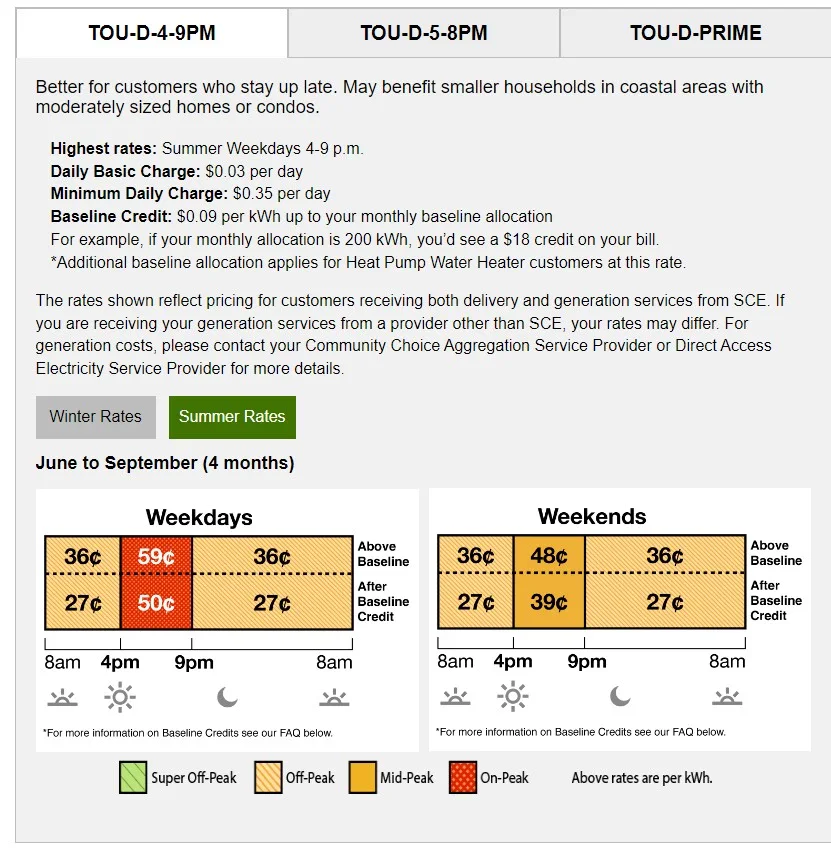
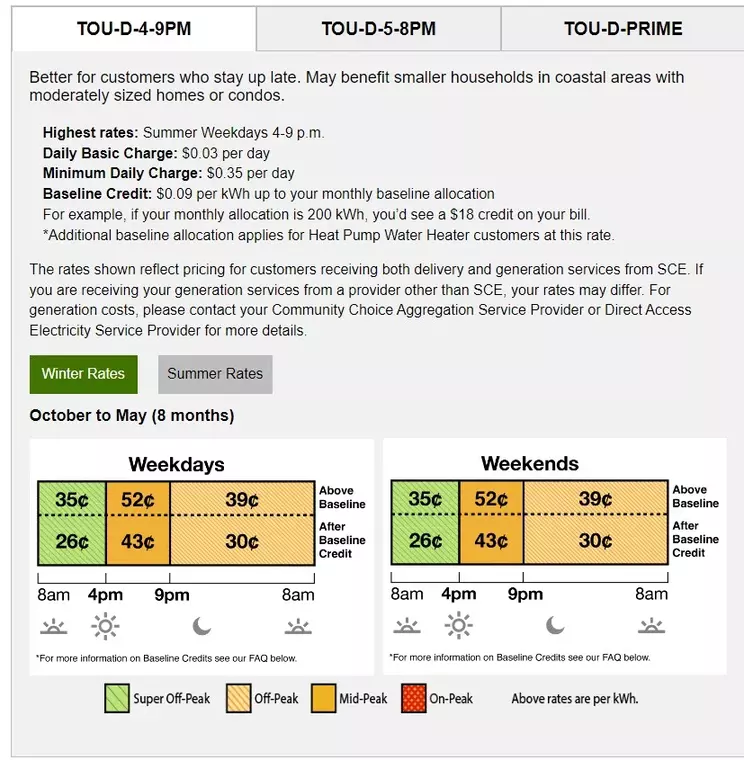
The top diagram is for summer (June – September), and the bottom is for winter (October – May) for SCE’s TOU-D-4-9 PM program. As you can see, during the summer peak hours, you will pay $0.49 per kilowatt-hour on weekdays and $0.40 on weekends. Other times it drops off significantly to lower costs. During winter, your peak costs stay at $0.43 for weekdays and weekends. There are two other programs available to solar customers: TOU-D-5-8 PM and TOU-D-PRIME. Taking the time to discuss your energy habits and use them with us will help you better assess which plan is right for you.
You can usually get more time out of your solar system in summer, but we still don’t want to depend on that in our calculations. Conservative estimates will protect you from underproducing and overpaying. You want to use most of your energy during the lower-cost periods, so solar has to either offset enough or have storage to get you there.
Read More:
30% Solar Tax Credit Is Back! – Inflation Reduction Act
Utility Rates Are On The Rise!
Solar Investment Tax Credit (ITC) – What You Need to Know
NEM 3 – Net Energy Metering Updates In 2022
SDG&E TOU
SDG&E did have two different solar rate plans: their “tiered” plan and the other TOU. Now, unless you installed solar before 2017, the tiered plan is no longer available to you. New and existing customers will be on SDG&E’s TOU, which is structured as follows:
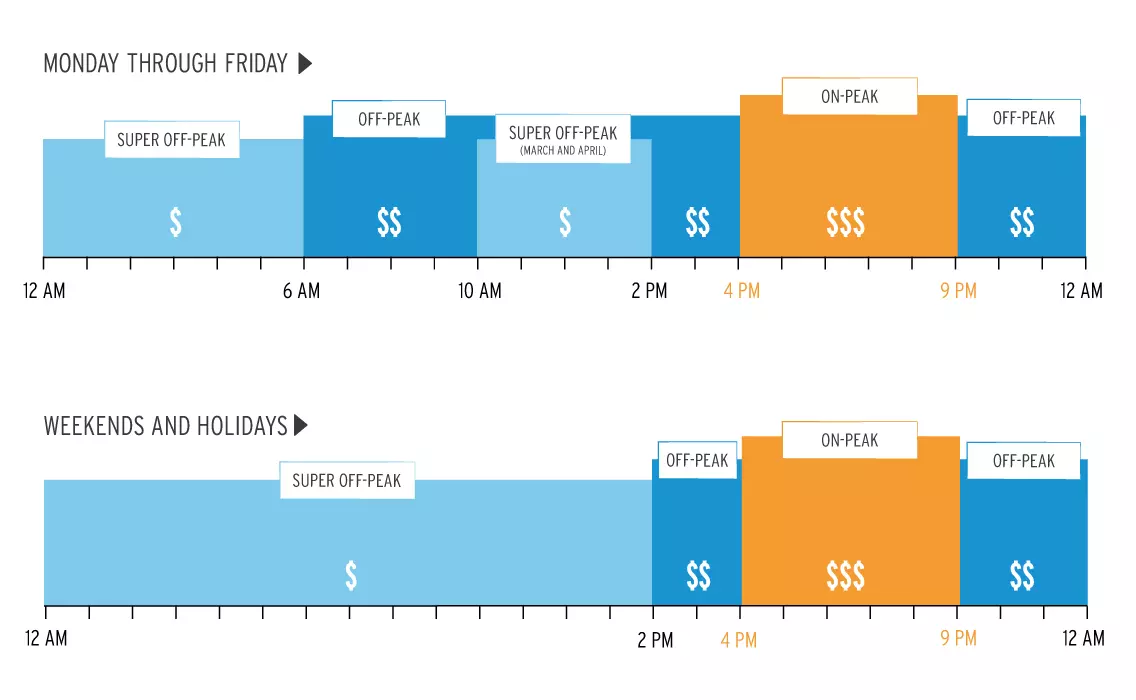
Now, you may already be on a Time-Of-Use plan with SDG&E, but if not, you definitely will see TOU on your bills from now on. From 4-9 pm, you will get either $0.41 or $0.33 on weekdays and weekends. That’s two different peak charges. Little confusing, but here is what they do. SDG&E has a “baseline” they have calculated as the normal consumption for the average user. That is what the dotted line in the chart represents. Once your usage passes that threshold, you get the $0.41 per kilowatt-hour charge instead of the $0.33. It is a tiered peak-usage system. The $0.41 is only the second tier. What they don’t show is their “high usage charge” around $0.50 per kilowatt-hour. Now you have to worry about not only using energy during peak hours but also how much. With a few exceptions, all customers will soon be on this price plan, so solar energy is more imperative for SDG&E customers.
The other times have a similar setup, but just lower costs. Underneath the dotted “baseline” threshold is where you start with your energy pricing, and it will increase as your usage increases. On weekdays you have the special off-peak prices between 6-10 am and 2-4 pm. Why worry about that many fluctuations?
To ensure you get the best return on your investment, our solar sales experts can accurately design a system according to your needs and answer any questions you may have about your utility’s rate plans.
LADWP Time-Of-Use
LADWP put their solar generating customers under their R-1B TOU Rate plan. LADWP’s solar time of use plan splits into three periods: High-Peak, Low-Peak, and Base. The base period is Monday-Friday from 8 pm-10 am and all day Saturday and Sunday. Your low-peak period will be Monday-Friday 10 am-1 pm and 5 pm-8 pm. High-peak falls between 1-5 pm Monday-Friday. LADWP customers do get the benefit of solar energy during the high-peak time. LADWP seems to be the most friendly utility for solar system owners utilizing these owners’ systems as pocket generators for the utility’s larger grid. The solar rate plan looks like the following (numbers in the graph represent dollar amounts):

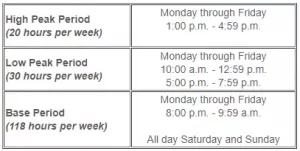
Los Angeles Department of Water and Power time of use rate
The above shows the current year and last year’s prices to give you a good idea of the year ahead. These numbers will stay close to the same until LADWP raises their rates, which all three of the utility companies mentioned in this article are poised to do this year.
LADWP high-peak and low-peak costs will both be around $0.21 per kilowatt-hour, with your base coming in at $0.18 per kilowatt-hour. You may see a difference in low and high-peak appear later in the year, as it did in June 2020. Still, a good solar system will help you offset all these charges.
NEM and Proper Solar Energy System Sizing
Now to the good stuff! Net energy metering, or NEM, is a program to calculate your solar energy production vs. your utility energy consumption. The meter will display production and consumption or automatically calculate and display one number as in some meter types.
Utility companies will record the measurements each month. Any balance you have left, you owe the utility or any credit you have they owe you. It is a simple system and regulated by the California State Assembly Bill 920. However, appropriate system sizing is essential.
Here is where the rubber meets the road and highlights the differences in solar installers. Pretty much all solar installers will calculate your consumption with a close approximation based on daily to yearly usage.
This method does a disservice to customers on a Time-Of-Use plan. Option One Solar utilizes a more accurate process of obtaining kilowatt-hour usage for the past year when designing your system.
Their attention to detail will save customers from different utility providers and those with varying use habits from paying more money due to an under-producing solar system on their home. Your system installer needs to be intuitive with their assessment and system design in order to give you more production and savings with your investment.
A system set up for daily to annual usage will not help you with the rate fluctuations under utility time of use rate plans. Go with a better installer who knows how to guard you against all situations.
Battery
Battery backup offers another advantage to solar system owners. Customers under these three utilities can take advantage of the SGIP incentive (while funds are available).
A battery backup system extends the hourly range of your solar panel system and gets a $0.25 per watt-hour of installed storage rebate under SGIP. This incentive helps minimize the impact of upfront battery systems’ installation costs and helps with a more holistic approach to residential solar.
Right now, owners get $200 per kilowatt-hour (kWh) of energy storage installed, which can equate to a $2,000 rebate for just installing 10 kWh of storage capacity. When getting a solar energy system, this option is something else to consider, and no one does it better than Option One Solar.
The time to act is now, with scheduled increases to utility rates planned and incentive programs coming to an end. Get your energy and financial independence now and get it right with the professionals at Option One Solar.










